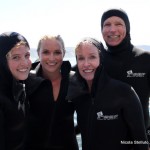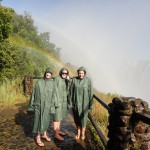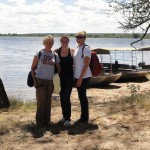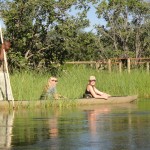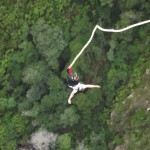AFRICA AWE, “Visiting Cradle of Mankind Gives Birth to Newfound Respect”
By Kathy Kemper | Uploaded on October 2, 2012This summer, my lifelong pursuit of responsible world citizenship continued with a family trip to one of the cradles of mankind: Southern Africa.
Gaining a better understanding of the world and an appreciation for different cultures starts with leaving your comfort zone — which is why, every two years, we head overseas for six weeks of adventure travel, alternating between camps and castles, between roughing it and luxuriating in five-star hotels.
We started nearly 10 years ago in 2002 when our daughters Kelsey and Christina were 10 and 12 with a trip to England, Ireland and Belgium. In 2004, we trekked to South America; in 2006, India; in 2008, China and Southeast Asia; and in 2010, Egypt and the Middle East. This year, we decided to go to Botswana, South Africa and Zambia.
If you have never been to a country or region before, it’s best to find a tour operator who understands what you want to experience. For our Southern Africa excursion, we found Craig Pieters ( craig@karell.com This e-mail address is being protected from spambots. You need JavaScript enabled to view it ), who was patient, professional, informed and eager to assist us. He immediately “got” what we wanted — adventure — and worked with us to organize an itinerary around “extreme” activities including shark diving, bungee jumping, sand surfing and biking in wine country, as well as educational experiences highlighting South Africa’s townships and the region’s various tribes, languages and ecotourism industry.
 Our daughter Kelsey was doing a junior semester at the University of Cape Town, and so our home base was the Cape Grace Hotel in Cape Town, South Africa (www.capegrace.com). The Cape Grace was a luxurious boutique retreat on its own private quay with bright views of the renowned V&A Waterfront, where boats and seals alike were docked.
Our daughter Kelsey was doing a junior semester at the University of Cape Town, and so our home base was the Cape Grace Hotel in Cape Town, South Africa (www.capegrace.com). The Cape Grace was a luxurious boutique retreat on its own private quay with bright views of the renowned V&A Waterfront, where boats and seals alike were docked.
Hoon, the hotel’s longtime concierge ( concierge@capegrace.com This e-mail address is being protected from spambots. You need JavaScript enabled to view it ), made us feel like we were coming home every day. He organized cocktail parties for college kids and private South African dinners in our suite cooked by the hotel’s award-winning chef.
When we were not relaxing at the hotel, we were out exploring with our local guide and knowledgeable point person, John Dunn ( jddunn001@hotmail.com This e-mail address is being protected from spambots. You need JavaScript enabled to view it ), aka “JD.” South Africa instantly awed us. Everything people say about Cape Town’s natural beauty could be amplified 10 times and it would still be true. JD was, moreover, the perfect guide for us — enthusiastic and intimately familiar with life in the bush, where we would be going on safari.
Our first adventure was shark-cage diving in Gansbaai, the great white shark capital of the world. JD took us on the two-and-a-half-hour drive to Gansbaai, where we were put in a cage and submerged into murky, cold, shark-infested waters. Seeing such terrifying yet magnificent creatures up close with only a metal rod separating us from their razor-sharp teeth was exhilarating, wild, scary and completely over the top! We swam with nine great whites that day — certainly one of the top five thrills I have ever experienced.
The rest of the day was packed with learning about conservation and the unique marine life that inhabits the Gansbaai area. Our hosts at Marine Dynamics (www.sharkwatchsa.com) study great whites and explained the role that sharks play in their ecosystem and how human activities are altering the ocean’s natural cycles. Marine Dynamics, in conjunction with the Dyer Island Conservation Trust (www.dict.org.za), is involved with various research and conservation projects concerning the marine “big five” — penguins, whales, dolphins, seals and sharks. Our hosts highlighted the importance of being aware of the links between ecosystems and educated us on ways to look after and cherish the environment.
Other adventures included sand boarding down the longest dune in South Africa, bungee jumping off the highest bungee bridge in the world, and biking through wine valleys in Stellenbosch and Franschhoek. JD arranged it all, taking pictures of us as we landed face-first into the sand and screamed for our lives as we fell from the bridge, driving the van behind us as we biked to ensure that we did not detour from our adventure.
The exhilaration was mixed with sobering history lessons offered by JD and an ex-political prisoner of Robben Island. This is where former South African President Nelson Mandela spent 18 of his 27 years of incarceration — and where indigenous slaves and political and religious leaders who opposed British expansion in South Africa, and most recently opponents of the apartheid regime in South Africa and Namibia, were imprisoned as well. Some freedom fighters spent a quarter of a century in prison.
JD also arranged a visit for us to the District 6 Museum in Cape Town (www.districtsix.co.za) and a tour of Langa, Bonteheuwel and Gugulethu, three townships located in Cape Town. Our guide, Thando, was a black man born in a prison after his mother was raped by a security guard but raised in a colored township after he was given to an 82-year-old woman. Thando himself spent several years in prison, labeled a “terrorist” for actions against the government’s policy of apartheid, which segregated blacks, Indians, Asians and whites.
He spoke frankly and passionately about his life and dreams for his country and took us to places that guests are allowed to visit only when accompanied by an inhabitant of the township. This experience was one of the most disturbing yet powerful I have had and proved critical to understanding South Africa’s past and future.
After immersing ourselves in South Africa, we flew to the Okavango Delta in Botswana, taking a boat ride through pristine, dazzling wilderness to Xigera Camp, run by Wilderness Safaris (www.wilderness-safaris.com) in the heart of the Moremi Game Reserve. Remote does not even begin to describe this wetland paradise. Otherworldly comes closer — deep channels, lush vegetation and water so clear you can see through to the white Kalahari sands at the bottom.
At Xigera Camp, we had close-up views of lions and leopards using the footbridge. At night, our guide Barodi had to walk us back and forth to dinner, cocktails, lectures and even the bathroom, keeping a watchful eye out for predators, which share space with an abundant variety of wildlife. Bird watching was a constant pastime, as we looked for species such as Pel’s Fishing Owl, African Skimmer and Lilac Blue Rollers. The delta, in fact, is an incredibly diverse region: Islands, river bends, tree lines, termite mounds and water holes reflect the evolution of this dynamic ecosystem.
In the camp, we traveled by mokoro, a dugout canoe. The only sound we heard was that of the reeds and papyrus lining the river quietly bending as we glided over them. The sky was mirrored in the crystalline water, dotted with round lily pads covered in brilliant pink and white flowers.
In the delta, conservation is a way of life. Setswana is the native language, while English is the official language. There are eight major Tswana tribes who live here; each maintains communal ownership over its lands. They cooperate and are proud of their stewardship in Africa’s growing ecotourism industry. Because South Africa and Botswana are democracies with bourgeoning tourism sectors, they are leaders in adopting and pioneering sustainable policies to protect their environment and natural resources.
Our next camp was Kings Pool, which we reached by taking a boat, a jeep and then a plane. We veered off course on the boat to avoid a hippopotamus pod, our jeep was stopped by three giraffes crossing the road, and our plane was forced back into the air due to an elephant blocking the landing strip. But we got there!
Our luxurious tented rooms overlooked a hippo-filled lagoon just 10 feet from our wooden-pole terrace. Elephants were also everywhere, as the area has the largest population, and the game drives were full of kudu and lechwe antelope, zebras, giraffes, waterbuck, wild dogs and cheetahs.
The guides taught us all about these amazing creatures. Groups of owls are called a parliament, hippos a pod, baboons a troupe, frogs a chorus, rhinos a crush, and giraffes a tower — this all becomes a part of your lexicon in the bush. We learned about the birth, life and death cycles of all the species we saw, and about how fundamental human nature is to the nature of the bush.
Early one morning as we were heading out for a drive, the camp was buzzing with excitement. A lion had given birth to some cubs. In the bush, this is akin to Kate Middleton giving birth. The guides knew the area but not the precise location of the birth. We headed out in eager anticipation. After two hours of careful searching, we found the mother nestled behind a huge fallen tree trunk and jungle foliage. We could even hear the babies. But we were not allowed out of the jeep and could only catch glimpses of the mother as she would lift her majestic head, look around, yawn, and settle back to rest. We learned that if the mother lion felt threatened, she would relocate. This could be fatal, as she could only move one cub at a time, leaving the others vulnerable. Male lions are happy to eat cubs, even their own. Such is life in the bush.
Our next stop was equally breathtaking, but on a grander scale: Zambia and Victoria Falls, which, I have to say, makes Niagara Falls look like a kitchen faucet.
Getting there was again an adventure. Our Wilderness Safaris guide and his driver picked us up after flying from Kings Pool to Kasane, Botswana. We drove through Kasane and witnessed the rich colors, sounds and scenes of daily village life. The guide handled passport control for us (otherwise we would have been in line for days), then drove us to a small motorboat that would transport us over the Zambezi River. We stood, just the four of us, at a spot where we could see the four corners of Zimbabwe, Botswana, Angola and Zambia come together. Motorboat is the best way to enter the country, we learned, because there is only one two-lane bridge connecting Botswana and Zambia, and it usually takes three to five days waiting in line to get over. That offered a larger-than-life perspective on how great the need is for funding infrastructure and cross-border cooperation in the region.
Victoria Falls (or “Mosi-oa-Tunya,” as Zambians say, meaning “the smoke that thunders”) was just as exhilarating as shark diving and bungee jumping.
The night we arrived, we learned that a lunar rainbow would be appearing. No one at our hotel seemed to know much about it, but with some doggedness, we made our way on foot, in the dark, to the falls for a peek. Lunar rainbows happen only 24 times a year. Zambia should advertise this phenomenon like an eclipse sighting — it was so remarkable, and yet so few folks turned out to see it.
The next morning we returned to the fall, donning giant green ponchos as we trekked along a path at the edge of the rainforest. Only the brave who are prepared for the tremendous spray and confident of their balance walk forward to Danger Point. The path is wet and slippery, water thrashes you, and the guardrails are flimsy. You are flirting with being washed away moment by moment. My heart did not settle down for hours afterward — I was so tired and wet!
But it was worth it. Victoria Falls creates a riot of rainbows, one on top of another. Between the slippery path, thunder-like booms, and constant slaps of water drenching us, Victoria Falls is as far out of one’s comfort zone as most of us can imagine.
For our final adventure, we returned to Cape Town in South Africa to hike along the city’s natural masterpiece, Table Mountain, and bike along the Southern Peninsula to Boulders Beach to visit a colony of African penguins.
When you stand on top of Table Mountain, you overlook a city and a country that has overcome an apartheid regime, but is still climbing out from underneath its aftermath. You view a country that pushes you to face your fears and embrace the unexpected, yet rewards you with extreme thrills and pride.
You see a nation that, along with Botswana and Zambia, is showing how ecological conservation and economic development can go hand in hand and do not have to involve tradeoffs. Much still needs to be done in Southern Africa, but standing atop Table Mountain, you’re in awe not only of what Mother Nature can create, but also of what a proud people and a resilient nation can accomplish.
About the Author
Kathy Kemper is founder and chief executive officer of the Institute for Education, whose mission is to encourage youth global citizenship and intercultural understanding, and to promote civility and leadership locally, nationally and in the world community.

